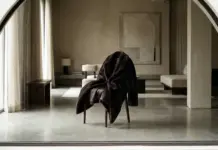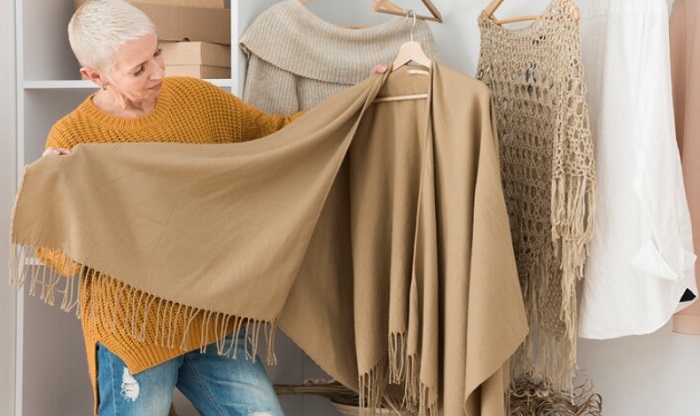The majority of items of clothing are either made by people or heavily rely on chemicals. On the other hand, linen is a naturally occurring fabric that comes from the flax plant, which grows without the need for fertilizer or pesticides, making it a sustainable and ecologically benign resource. Furthermore, there is no waste since every component of the flax plant is used. Beyond its resilience, breathability, and strength, linen has many more amazing properties that have made it a beloved textile for generations. Not only are items made of linen durable and fashionable, but they are also of the greatest quality.
The Linen Fabric’s History
Almost every nation has grown flax for thousands of years, and the plant is used to make fiber. Based on archeological findings from a location in present-day Georgia, linen has been used by humans for around 35,000 years, since the Palaeolithic period1. Because linen was so precious in antiquity, it was employed in Egypt to wrap mummies’ corpses, aiding in the preservation of these historical relics.
Throughout history, military operations have valued linen for its antibacterial and antifungal capabilities. These days, US dollar bills are made of a sturdy, paper-like substance that is a combination of cotton and linen. Europe used to be one of the top manufacturers of linen, with France at the top. China now produces the bulk of the flax yarn used worldwide. The production of high-quality linen products continues to be an important aspect of the cultures of many European countries, with Ireland, Italy, and Belgium remaining significant linen producers, notes Boris Hodakel, the founder and CEO of Sewport.
The Method Used to Make Modern Linen Fabric
The method used to make linen in ancient Egypt is almost unchanged today. The flax plants are either plucked from the ground or manually cut; it is thought that pulling produces linen with a finer texture. The flax is harvested and allowed to dry for a few weeks. The next stage, called threshing, is pulling the seeds from the stalks by tearing or winnowing them. Strengther fibers may result from harvesting flax before the seeds reach full maturity.
It is essential to rettel, or steep the flax stalks in water, in order to remove the fibers from the stalk. The plant’s interior cells are broken down during this soaking procedure, making it possible to gather the intact fibers. Following retting, the plant material is extracted from the fibers, which are further divided to gather the longest segments—which may sometimes measure up to eight inches. These fibers are then twisted into yarn and sewn into cloth.
Why is linen so widely used?
Because it may feel cool in the summer and warm in the winter, linen fabric is highly acclaimed for its capacity to provide comfort in all seasons. It can absorb up to 20% of its weight in moisture before feeling wet because of its remarkable moisture absorption capacity. This feature is especially helpful on hot summer days as it helps avoid unpleasant wetness and noticeable sweat stains. It’s interesting to note that linen keeps up quite well and becomes softer with every wash and use, while other fabrics may degrade with time.
Beyond being used for clothes, linen may be used for a variety of crafts, including artisan baking, oil painting on canvas, and even as part of the US dollar note. Its adjustable weave gives it a breezy, light feel that’s perfect for summer clothing.
Moreover, because of its thermoregulating, antibacterial, and hypoallergenic qualities, linen is advantageous for those with skin allergies and sensitivities. In comparison to other materials, it is also more ecologically friendly since it uses less water, lasts longer, and requires fewer washes. Furthermore, washing linen does not introduce microplastics into the water since it is a natural, plastic-free substance. In fact, linen is the ideal fabric for a variety of applications and for all age groups.
The Adaptable Material
Given that it was the first cloth ever used by humans, linen is very versatile. Its inherent stain resistance makes tablecloths, napkins, aprons, and towels a great asset in the kitchen. Because of its superior absorbency and quick drying qualities, linen is sanitary for regular usage and helps inhibit the formation of microorganisms. Because linen doesn’t stick to the skin and allows for a nice, airy sleep throughout the night, it is also in great demand as bedding. Some people compare its smoothness to lying on a cloud.
Linen’s remarkable quality and unique crispness allow for a plethora of inventive applications. Thus, it should come as no surprise that apparel composed of linen often has sophisticated, timeless styles that are appropriate for both men and women.
Different Kinds of Linen Fabric
There are several sorts of linen depending on the weave pattern, texture, and weaving technique.
Damask Linen: Traditionally used for crafts rather than clothing, this intricate and delicate linen fabric is woven on specialized looms to resemble embroidery. Damask linen is often used in home décor items like tablecloths, napkins, and drapes. Its rich look and elaborate patterns provide an air of refinement to any environment. These products may be enjoyed for many years to come because to their durability, which also improves the atmosphere of any house.
Plain-woven linen is often used for hand and bath towels and is renowned for its rough texture. Plain-woven linen is very durable, making it perfect for towels since it can resist several washings and usage without losing its quality. It provides a soft, friendly, and sanitary alternative that encourages cleansing thanks to its inherent antibacterial and hypoallergenic qualities.
Loosely Woven Linen: This kind of linen is highly valued for its absorbency and breathability, and is often used for craft fabrics and reusable diapers. While it may not be as strong as other forms, its softness and light weight make it comfortable and kind to delicate skin, so it may be used with sensible and sustainable fabric options.
Sheeting Linen: With a high thread count and a smooth, silky surface, this tightly woven fabric is substantial and durable, making it a popular choice for clothes and bed linens. Because of its plush texture and long-lasting nature, sheeting linen is perfect for clothing and bedding that are used often and provide excellent comfort and elegance to any bedroom.
Blends of linen and cotton combine the greatest qualities of both fabrics to improve wearability, softness, and wrinkle resistance. These mixes are more affordable than pure linen, which makes them a more viable choice for those looking for the benefits of linen with greater usefulness and worth.
Why Clothes Made of Linen Are Seen as Luxurious
Not only is linen expensive, but there are a number of additional strong arguments for why it is considered a luxury item. The most renowned quality of linen is perhaps how durable fabric is, enabling objects made of it to be handed down through the generations undamaged. Despite the initial outlay, this custom not only adds emotional value but also gradually reduces the cost of linen garments.
Another feature that sets linen apart from other textiles is its distinct, opulent, and somewhat gritty feel. Richer, warmer colors that grab the eye are produced by the fabric’s improved capacity to absorb dyes due to its thicker weave. In addition, linen’s health advantages are making it a more popular choice. It is the healthiest option when it comes to materials since it is hypoallergenic and provides UV protection. Its anti-static qualities make it more resistant to dust and stains, and studies have shown that they may cut the effects of radiation in half.
Additionally, linen is quite useful for travel since it is simple to care for, takes up little room in a luggage, can be hand washed, and air dries in about 20 minutes.
Because of its durability, linen may also be passed down to future generations and worn for many years, which increases its value and attractiveness. A linen wardrobe may save money and time over time, even if it is initially more costly. Linen’s reputation as an opulent and sensible fabric option is cemented by its dye-able vivid look, advantageous qualities, and simplicity of maintenance.
What Makes Linen So Popular Among Designers of Fashion?
The fashion industry is beginning to regard linen with an unparalleled level of respect as sustainability gains popularity. Because linen is renewable, designers use it. They understand that choosing the correct materials is essential to remaining relevant and using more eco-friendly manufacturing techniques. But there are other factors as well. The softness, comfort, coolness, breathability, and opulent feel of linen make it highly valued.
Linen has the potential to become a very sought-after fabric as its demand increases. Purchasing exceptional quality linen yields a beautiful, reasonably cost product that lasts for many years. Fashion designers that are well-known, like Dior, Prada, and Gucci, often include linen in their collections to keep their styles cutting edge.
Furthermore, because of linen’s adaptability, designers may make a broad variety of clothes, from sophisticated evening dress to casual wear, to suit a variety of preferences and events. Its natural fibers provide garments a distinct feel that enhances their overall visual appeal by giving them more depth and personality. Because of its ability to absorb moisture, linen is perfect for warm regions and provides comfort even on the warmest days. Because of its endurance and durability, it is a prudent investment for both designers and customers. Linen continues to be a classic option that flawlessly reflects both sustainability and quality, as the fashion industry continues to highlight these values.
Advantages of Clothes with Linen
With so many advantages, linen is a popular fabric for clothes. The following six benefits of dressing in linen:
- Durability: Because of its longer and more tightly wrapped cellulose fibers, linen is known for being two to three times stronger than cotton. This characteristic guarantees the exceptional longevity of linen clothing. Clothes made of linen may last for generations if properly cared for. It also never goes out of style. But, it’s crucial to confirm that the linen is 100% pure since some producers may not utilize it, which lowers the quality. Weight, fiber strength, color, texture imperfections (such as slubs or weaving errors), propensity to wrinkle, and moisture-wicking qualities are important markers of premium linen.
- Eco-friendly: Among the most sustainable fabrics is linen. It comes from the flax plant, which is a low-impact resource since it consumes a lot less water and doesn’t need any fertilizer or pesticides than other crops. Furthermore, there is very little waste since the whole plant may be utilized to generate fiber. Additionally, linen is completely recyclable and biodegradable, although it’s important to think about how the colors used may affect the environment.
- Temperature Regulation: By serving as an insulator and a ventilator, linen naturally controls body temperature. It is thus perfect to wear in both warm and chilly weather. The hollow fibers of linen promote airflow, keeping the user warm in the winter and cool in the summer. Because of its dual use, linen clothing may be worn all year round in comfort.
- The antibacterial properties of linen serve to limit the growth of germs by preventing moisture retention. Unpleasant odors are avoided by the fabric’s rapid rates of absorption and evaporation, which stop the development of fungus, bacteria, and other microorganisms.
- Hypoallergenic: If you have delicate skin or allergies, linen is a great option. Sensitive skin may feel secure and at peace with it because of its exceptional breathability and rapid moisture release, which lessen the possibility of bacterial development and allergen buildup.
- Anti-static: Clothes made of linen produce less static electricity than clothing made of other materials, which makes them less prone to stick to the body or give off static shocks. Wearing linen is more comfortable because of this characteristic, particularly in dry climates.
Linen Clothes’ Effect on Sustainable Fashion
Throughout fashion history, linen has been valued for its biodegradable qualities as well as its fashionable look. It requires 60% less water than cotton3 and grows fast, flourishing even in unfavorable soil. This makes it an eco-friendly option.
Furthermore, the whole flax plant is used to produce linen, increasing its affordability and decreasing waste. Due to its total biodegradability, linen doesn’t end up in landfills. Furthermore, because of its great absorbency, linen does not hold on to germs, reducing the need for frequent washings, extending the life of clothing, and therefore increasing the sustainability of wardrobes.
Because of its inherent texture and adaptability to a wide range of styles and patterns, linen is becoming more and more popular among fashion designers and manufacturers. Because it breathes well and absorbs moisture, linen is especially well-liked for summer clothing because it keeps users dry and cool.
With ideas like capsule wardrobes—which are made up of classic, adaptable items that can be combined to create a variety of looks—sustainable fashion promotes the usage of linen. This strategy encourages durability and minimizes wardrobe size, which lowers the need for regular purchases.
Additionally, linen supports ethical fashion manufacturing methods. Companies that use linen often place a high priority on fair labor standards, making sure that employees are paid fairly and have safe working conditions. In addition, eco-friendly fashion labels strive to minimize the environmental effect of the fashion business by using packaging materials that are recyclable or biodegradable.
As a result, linen apparel is essential to the sustainable fashion movement since it provides a long-lasting, ethically made, and environmentally friendly substitute that promotes social responsibility and environmental preservation.
Trends in Linen Clothing for 2024 and Beyond
Linen has been associated with class and refinement throughout cultures and historical periods; this was especially true of the European nobility in the Middle Ages. The manufacture of linen underwent a dramatic change throughout the Industrial Revolution, going from a labor-intensive handicraft to a more mechanized method. The 21st century has seen a resurgence of fashion and bedding trends due to the growing popularity of sustainability and customer demand for natural textiles and comfort. The following linen-inspired looks are anticipated to be popular until 2024 and beyond:
- Relaxed Silhouettes: Oversized shirts, flared slacks, and elegant linen dresses are all the rage on the fashion runways. In the industry, linen’s airy and light texture has come to represent carefree elegance, particularly for loose shapes. The fashion industry is adopting a more carefree attitude, with loose cuts and billowy legs providing a welcome change from tailored trends. This demonstrates that comfort and style are compatible.
- Natural Textures: Because linen is so versatile, it can be easily combined with other fabrics, such as silk, wool, or leather, to create clothes that are both pleasurable and aesthetically pleasing. With its textured feel, the fabric’s adaptability connects consumers with nature and provides depth and richness to apparel and home decor—a quality that is becoming more and more prized in our digitally disconnected culture.
- Earthy Color Palettes: Earthy and neutral colors are still popular in clothing and interior design. This is because linen reflects and absorbs light well, giving the material a classic and peaceful look. Linen fabrics give subtle beauty to closets and bring a little of nature within, available in a range of colors from light greys to sandy beiges. These colors are especially well-liked for wedding table linens because they let couples take use of the inherent beauty of the material.
- Wrinkles as a Statement: The natural creases in linen have gained popularity among aficionados as a sought-after aesthetic, giving the cloth a cozy, worn-in look. Accepting these inherent creases gives clothing and home décor a relaxed elegance while showcasing linen’s genuineness and easy appeal. The distinct texture of linen is enhanced by its wrinkly appearance, which is hard to imitate with other fabrics.
- Linen for Homeware: Because of its timeless design and breathability, linen is becoming a more and more popular material for tablecloths, curtains, and bed linens. Its ability to regulate temperature improves contemporary life and home comfort. Because they are cooling, linen bed linens are quite popular in the hot months and are perfect for summer bedding. In the kitchen, linen is a great material for dish towels, aprons, and tablecloths because of its strength and capacity to dry quickly. Its low shedding also guarantees that dishes don’t contain any small fibers after drying.
Final Thought
Despite its initial expense, investing in linen apparel shouldn’t be seen as a turnoff. Over time, wearing linen might prove to be a financially advantageous choice. This fabric is stain-resistant and retains its quality after several washings, so less frequent laundry is needed. It’s not necessary to use pricey products or tumble dryers to maintain linen. Linen clothing may be dried in only twenty minutes by just hanging it outdoors and using a mild cleaning solution.
Even though linen is notorious for wrinkling readily, its unique quality is often regarded as one of its most endearing qualities. Because it does away with the necessity for ironing, it also uses less power. Linen items may simply be made wrinkle-free for individuals who like their clothing that way. Just give them a short spray of water. The ease of traveling with linen is another wonderful feature. Clothes made of linen take up less room in a luggage when rolled as opposed to folded. Anywhere one goes, one may appear effortlessly fashionable by just hanging them up when they arrive.



































